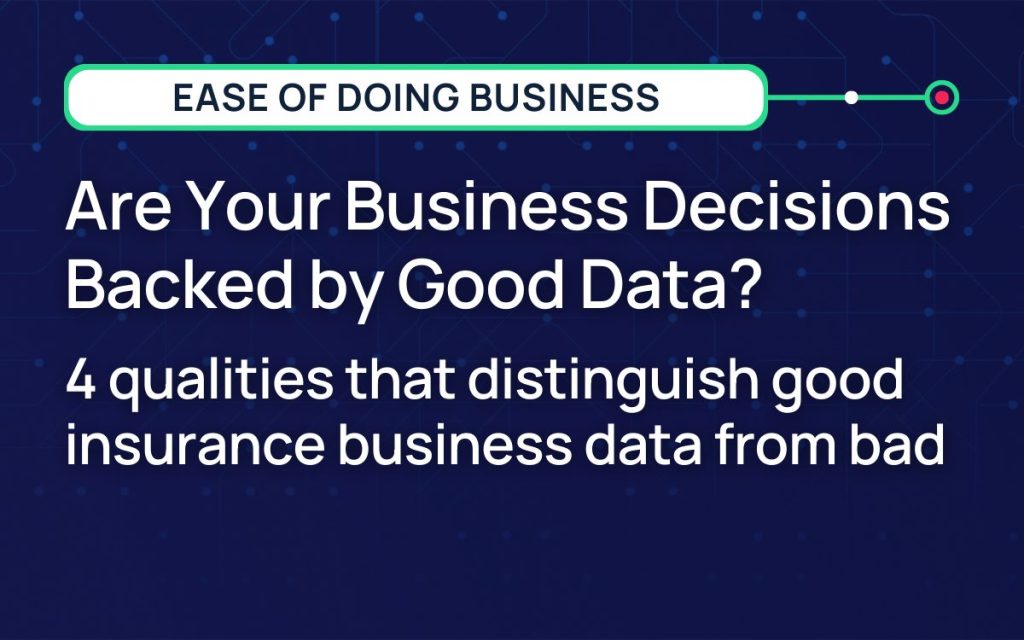Are Your Business Decisions Backed by Good Data? 4 qualities that distinguish good insurance business data from bad

America may run on Dunkin’, but insurance runs on data. Data impacts every part of insurance. Underwriting, rating, pricing, forms, marketing, claims handling — you name it, data influences it. Even the very foundation of our beloved industry is built on actuarial tables composed of hundreds of points of statistical data used to better predict risk.
Good insurance businesses use data to better understand their customers. Better insurance businesses use data to support not only their customers, but also their producers and their own processes. Bottom line: data is key to driving organizational growth. But the business decisions you make are only as good as the data you use to make them.
What makes insurance business data good?
Armed with good data, companies can make informed decisions about their processes and improve the way they operate. But what makes data “good”?
It’s accurate and complete
A business can have access to all the data in the world, but it won’t be of much use if the information’s outdated or incomplete. Consider the producer onboarding process, or, to make things a little more complex, the variable lines broker onboarding process.
Getting a new variable lines broker onboarded and ready to sell requires collecting a ton of data. From background checks to E&O policies to verifying state insurance licenses and FINRA registration, it’s vital the information you receive is accurate and up-to-date to ensure no one’s selling with an expired or invalid license.
Inaccurate and outdated producer or variable lines broker data adds uncertainty and unnecessary costs to a company’s distribution management processes that can negatively impact the ability to adapt and scale.
It’s structured
If you want an in-depth explanation of the difference between structured and unstructured data, you can read all about it here. The main thing to note is that unstructured data, like emails, word documents, and paper files, is much less efficient, accessible, and secure than structured data.
Too often, unstructured data is messy, redundant, and inaccurate. Think about how difficult it is for an insurance agent or customer service representative to answer a policyholder’s question when their personal information and policy data is scattered across several different locations. It can make even a simple task, like adding a new vehicle to an auto policy, much more tedious.
With structured data, information is collected, organized, and stored in a way that enables both people and technology to easily access and analyze it. Structured data gives business leaders a clearer view of what’s happening across each part of their organization and during each step of their processes.
It’s customizable
If you’ve already ditched locally stored spreadsheets and paper files in exchange for a cloud data warehouse, you’re on the right track to unlocking good data. Often, the modern software systems you use to store your data can organize it into reports and dashboards in a way that gives you the insights you need to make better-informed decisions.
These days, it’s pretty standard for software vendors to offer a set of generic reports that your company can access with the click of a button. However, generating more detailed, specific, and customizable reports may not be possible, at least not without added costs. (Shameless brag: At AgentSync, we believe your data is yours and you should be able to use it however you want, without incurring extra fees).
With the ability to slice and dice business data to fit specific needs, insurance carriers, MGAs/MGUs, and agencies can expose process roadblocks, team inefficiencies, growth opportunities, and more.
It’s easily digestible
If you’re not a particularly technical person, large quantities of data can feel scary and hard to digest. While it’s important for your data to be easily readable and sharable across your entire tech stack, sometimes the human aspect is lost in translation.
For instance, when you think of the lines of authority a producer is licensed in, you probably think of words (like life, health, property, and casualty) rather than numbers. Your producer management software might analyze and interpret the lines each producer holds using numerical values, but if the information isn’t presented back to you in a way that you can easily understand it becomes difficult to contextualize the data and use it to make informed business decisions.
How better data can benefit your insurance business
So your data checks all the boxes above, now what? Carriers, MGAs, and agencies should use their data to assess their current processes and drive both vertical and horizontal growth. Equipped with good producer data, insurance organizations can:
- Eliminate workflow bottlenecks: With outdated, unstructured data, essential business processes like producer onboarding can be painfully slow. Your compliance team might be spending weeks (or even months!) tracking down all the information needed to validate a producer’s license. Having accurate, up-to-date data that your team can easily access when they need it most makes the entire onboarding process a lot quicker and a lot less painful for everyone involved.
- Improve the producer experience: Is there a drop-off point at which you’re most likely to lose producers? Does it take way too long to get a new producer onboarded and ready to sell? Your data can tell you this! In a time when hiring and retaining top talent is harder than ever, creating a world-class producer experience is crucial to your organization’s growth and success.
- Reduce costs: Unreliable producer data costs you more than you think. For starters, there’re the more obvious costs. Compliance violations like missed renewals, CE deadlines, or appointments carry some pretty hefty fees. There’s also the less visible (but just as lofty) expenses associated with bad data, like operational inefficiency and wasted manual effort. Having access to accurate and complete data exactly when you need it removes these unnecessary costs from your bottom line.
Unlock better business data with AgentSync Manage
Carriers, agencies, and MGA/MGUs rely on high-quality data to improve their processes and power their growth. Unlocking your insurance organization’s data can lead to clearer insights into your distribution channel, a better understanding of which partners drive growth, and the ability to identify expansion opportunities that allow your business to scale intelligently.
With AgentSync Manage, customers receive the most up-to-date producer license and appointment data all in one convenient location. Our custom reporting capabilities give you visibility into your entire distribution channel in the way that best fits your unique business needs and with no additional fees. If you’re ready to use better data to make better business decisions, schedule a demo today.

